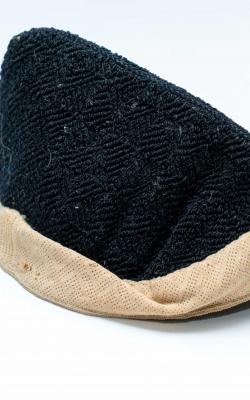“Ceapsa” is a part of the headdress worn by married women in some areas of Transylvania and Banat. It can also be described as a bonnet with fine, geometric, woven and stitched embroidery. Depending on the area from which it comes, it presents a great morphological variety, which places this piece of garment in several areal variants with distinctive features. “Ceapsa” appears as an element that completes the folk costume, perfectly harmonized with the sobriety and elegance of the costume of the region where it comes from.
This week’s artifact is a “ceapsă” specific to Pădureni Land, an area in which it was worn over the bun, and on top of this piece, another piece, “cârpa” was placed, a white towel that matched a longer and a shorter end. “Ceapsa” in the picture has a conical shape, it is made of white cotton and hemp cloth, woven, over which the decoration is made, by sewing, from colored wool (dark blue). On the edge, “ceapsă” has needle lace, which is then sewn over the base material. The stitched motifs are geometric (diamonds). The decoration is arranged on the entire surface of the pieces, except for the edge.
The artifact has inventory no. 304, it entered the museum’s heritage in 1923, and it was purchased from Lelese, Hunedoara county.
(Bibliography: Dictionary of Romanian folk art, authors: Georgeta Stoica, Paul Petrescu, Maria Bocșe, Scientific and Encyclopedic Publishing House, Bucharest, 1985; Ioan Godea, Romanian Ethnological Dictionary, Ethnological Publishing House, Bucharest, 2007.)
Text: Flavia Paula Stoica – museographer
Photo: George Ciupag – photo-video museographer











